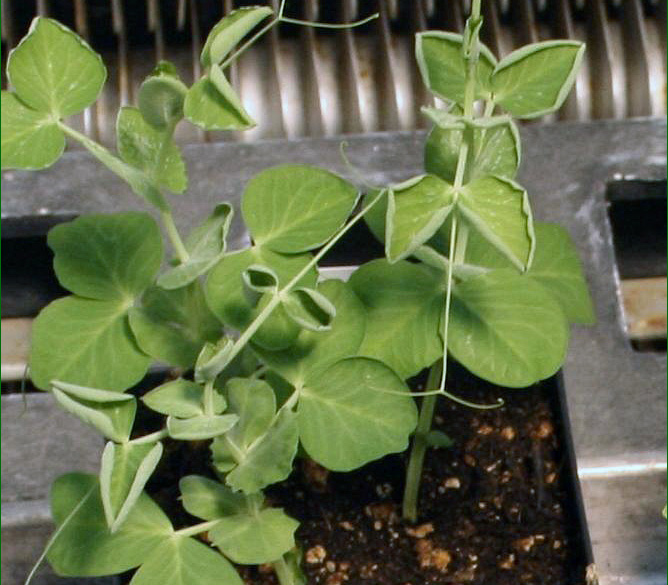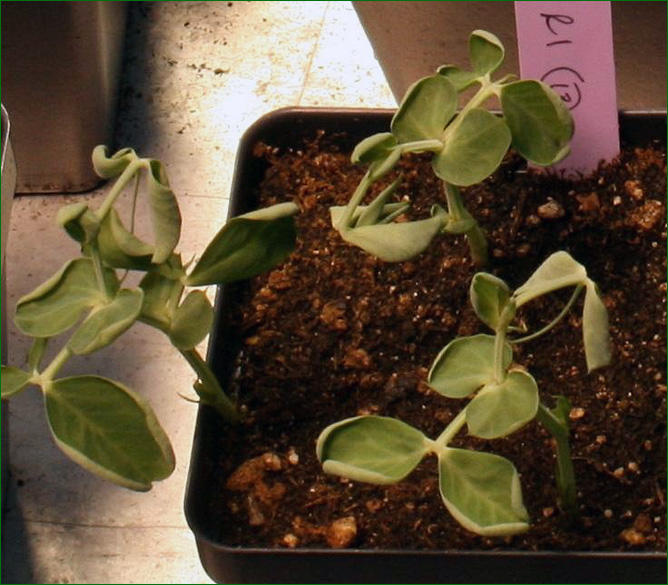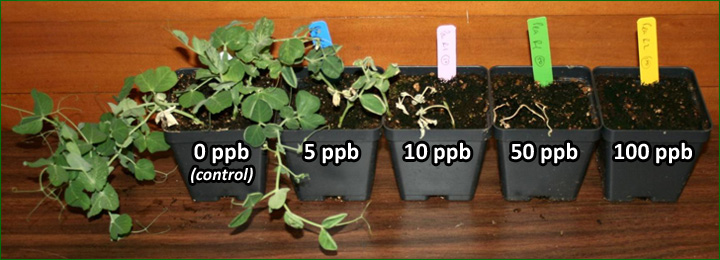Herbicide Contaminated Soil and Amendments
Revised October 2019
For the past decade, herbicide contamination of soil in home gardens, greenhouses, nurseries and agricultural land has become prevalent where plant growth regulator (PGR) herbicides, also known as synthetic auxin herbicides, have been applied, or where soil amendments contaminated with these chemicals have been added. Persistent PGRs target annual and perennial broadleaf plants through disruption of several growth processes including cell division, respiration and protein synthesis. PGRs that can persist within the environment, are a subgroup of PGRs known as the Pyridine Carboxylic Acid (PCA) herbicides, and do not break down easily, even passing through animal digestive systems and composting facilities. These herbicides can be useful in specific situations, however, when misused, they can cause significant damage to plants and crops.
The source of PGR contamination often comes from soil amendments such as compost made with an input treated with a persistent herbicide such as hay or manure. In agricultural systems the damage is likely to come from herbicides residing in the soil, possibly from a direct application to grasses or small grains in previous years, which did not break down in the growing season they were applied.
MSU Schutter Diagnostic Laboratory routinely receives plant samples with damage consistent with herbicide injury specifically from PGRs. Symptoms of Injury from PGRs include cupping of leaves, stunting of plants, and twisting of growing plants. Not all plants are susceptible – PGRs mainly impact plants in the legume family (peas, beans, lentils and clover), the solanaceous family (tomatoes and potatoes), the composites family (sunflower, petunias, daisies, lettuce and asters), and the cucurbit family (cucumber, squash, pumpkin and watermelon),
The active ingredients currently available on the market showing the most prevalent cases of PGR herbicide injury in Montana are aminocyclopyrachlor, aminopyralid, clopyralid and picloram.


Although other persistent chemistries may cause issues (i.e. sulfonylurea, atrazine, etc.), especially from direct applications on agricultural land, PGR chemistries constitute the bulk of contamination from carryover in small grains or soil amendments introduced to various location. For diagnosing injury from other modes of action navigate to the University of Arizona Cooperative Extension Herbicide Injury Key. For further assistance contact your local MSU Extension agent, or the MSU Pesticide Education Program. If you wish to seek reimbursement for damages contact the Montana Department of Agriculture Pesticide Enforcement Program at (406) 444-3144.
Selecting Non-Contaminated Soil Amendments
In order to select non-contaminated soil amendments, you will need to do some homework. When purchasing soil amendments ask manure and compost producers how they handle herbicide contamination. Ideally, they will reduce use of inputs which may have persistent herbicide residues. Compost and manure producers should also do bioassays on the finished product prior to sale as lab testing can be inconclusive on whether the inputs or a finished product will cause herbicide damage. Another safeguard compost producers may use is to add activated carbon or carbon wood ash to their finished compost which binds herbicides and makes them inactive. Compost producers may specify how to use their products. If they recommend using a product only on lawn or grasses do not use this for susceptible plants as it may contain persistent herbicides.
The best way to determine if the soil amendment you have purchased is contaminated with herbicide residual is to do a bioassay prior to applying to your garden. If you find there is some contamination, return the soil amendment to the place of purchase. You not only should get your money back, but the distributor may not know about the issue. You may save countless other people from having contaminated soil. If the distributor does not respond to your request, contact the Montana Department of Agriculture about the issue.
These instructions are intended to determine whether the test material (compost, soil, manure or other material) causes plant growth symptoms consistent with growth regulator herbicide or auxinic herbicide damage in susceptible plants. These instructions were created by Washington State University Whatcom County Extension.
Materials
- Test material (soil amendment or topsoil)
- Potting mix (commercial, compost-free, peat-based mix)
- Plastic pots
- Plastic saucers
- Garden pea seeds
- Plastic bags
- Disposable gloves
Instructions
- Setup control pots. Fill three pots with potting mix. Label.
- Prepare test pots. Fill three pots with test material. If testing compost or manure mix two parts test material to one part potting mix in a clean plastic bag. Label pots.
- Plant three pea seeds in each pot just under the material's surface. Record planting date. Place each pot on an individual saucer.
- Grow plants. All pots should have similar growing conditions with consistent light, temperature and water.
- Evaluate plants. Record germination dates for each pot (two seeds must germinate to record). Grow until three sets of leaves appear (14-21 days). Compare plants grown in test material to control pots (potting mix). Determine level of herbicide damage using the images below as a guide.

Figure 3. Results from a bioassay done with known concentrations of aminopyralid six weeks after planting. At high levels there was no germination or plant death. At five parts per billion (ppb) there is leaf curling. The 0 ppb (control) pot shows what a healthy plant should look like under the same growing conditions without herbicide damage.
Information for Land Owners Suspecting Herbicide Injury
If you suspect herbicide injury on your property you will need to conduct an investigation to determine the source and the best options for moving forward. You will need to try to determine if: (1) a pesticide was applied directly to the site, (2) a pesticide traveled through drift to your property, or (3) if injury symptoms coincide with application of soil amendments.
Once you have determined the most likely source you have a few options. If you applied an amendment and you discover this is the likely source of herbicide damage, it is good to notify the producer or dealer of the amendment about the issues you are having. With all the potential sources listed above you have the option to contact the Montana Department of Agriculture to determine your options on pursuing legal action in order to recoup loses sustained by the herbicide damage.
Options for Remediating Herbicide Contaminated Soil
Soils and amendments with herbicide contamination are not poisonous or toxic. They should not be used where susceptible plants do or may reside, but they can be used in other locations such as on lawns and other areas where grasses or other non-broadleaf plants are desirable. Steps may be taken to remediate soils already contaminated with persistent herbicides though these procedures can be time consuming and costly.
Keep in mind each location and soil will have different rates and successes with remediation. These techniques are very dependent on the herbicide concentration and environmental conditions which can vary greatly from site to site. The options listed below are general techniques which should reduce concentrations of herbicide in your soil. These techniques may not solve your herbicide injury problems if they are not able to reduce herbicide concentrations enough to not impact susceptible plants.
Option 1: Do Nothing
The easiest and most time and money conserving option is to do nothing or move the location of your sensitive plants to a non-contaminated location. Eventually the herbicide will breakdown and in the meantime the soil can be used for non-susceptible plant gardens or lawn. If you intend to plant susceptible plants in the future perform a bioassay before planting. Keep in mind, depending on environmental conditions, persistent herbicides can take years to fully breakdown within soil.
Option 2: Increase Breakdown of Herbicide through Microbial Degradation
Microorganisms utilize herbicides as food within soil. Microorganisms need food, water and oxygen to be healthy. You can increase microbial breakdown of herbicides in your soil by tilling (adding oxygen), and adding water water and non-contaminated organic matter to the soil. This combination will allow microorganisms to proliferate in the soil and increase the rate of herbicide breakdown. Applying a fertilizer may also help increase microbial breakdown and also support plants growing in the soil whether they are the permanent plants or a cover crop. Two manufacturers with products marketed for herbicide remediation is Soil Diva and Algae AquaCulture Technologies. There are currently no scientific studies available on the efficacy of these products, however anecdotal evidence suggests products like these designed to increase microbial growth may help increase the rate of herbicide breakdown (see the Whitefish High School Case Study below).
Option 3: Use a Cover Crop
You can use a cover crop to bioaccumulate the herbicide. You will need to remove the plant in its entirety at the end of the growing season and dispose of it where it will not cause additional soil contamination. Some species suggested are sunflowers, oats, peas, radishes, corn, and wheat, or a non-sensitive plant with high summer biomass production.
Option 4: Use a Carbon-Rich Soil Additive
Carbon-rich soil additives include activated charcoal and biochar. When either is applied to soils they bind herbicide particles, making them inactive. A suggested rate of activated charcoal for homeowners is one pound activated charcoal in one gallon of water for each 150 square feet. Biochar varies widely so it is recommended to follow the manufacturer's instructions on application rates. A downfall of applying a carbon-rich soil additive is they can increase soil pH which can be an issue for parts of Montana. Biochar also may contain varying amounts of organic pollutants which could be a hazard to human health. Application of these additives may also reduce efficacy of future pesticide applications by binding the pesticides in the soil.
Option 5: Remove the Soil
Removing contaminated soil is the most expensive and labor intensive option. You will need to remove all the contaminated soil and dispose of it properly. You can then fill in the area with clean topsoil and replant. It would be good practice to do bioassays of the soil left on your property once digging out the topsoil and on the new topsoil to avoid additional problems.
In 2018, the Whitefish High School (WHS) Center for Sustainability and Entrepreneurship noticed plant symptoms in their greenhouse consistent with herbicide injury from persistent herbicides. After soil testing aminopyralid was discovered in the soil. WHS turned this into a teaching and learning opportunity for their students and set up a project to determine how they may remediate the soil in their greenhouse.
Students researched potential remediation techniques and plots were treated over a three-month period. Many of the plots used a cover crop mix consisting of sunflower, oat, pea and radish.
Methods of Herbicide Remediation
- Regenisys with Cover Crop - Regenisys is an algae based fertilizer produced by Algae AquaCulture. This was applied at one cup Regenysis per gallon of water per 60 square feet. Afterthe treatmentperiod aminopyralid levels decreased by 78%.
- Regenichar with Cover Crop - Regenichar is also produced by Algae Aquaculture and was applied by mixing one gallon into two cubic feet of soil. This soil was then broadcast over 150 square feet. The cover crop mix was planted in this plot. Afterthe treatmentperiod aminopyralid levels decreased by 66%.
- Fungal Compost with Cover Crop - A local compost producer provided a fungi rich compost that was applied along with the cover crop mix. After the treatment period aminopyralid levels decreased by 64%.
- Biochar with Cover Crop - An application of biochar with the cover crop reduced aminopyralid concentrations by 17%.
- Activated Charcoal with Cover Crop - Activated charcoal with the cover crop reduced aminopyralid concentrations by 6% over the treatment period.
- Compost Tea with Cover Crop - Compost tea applied to a plot with the cover crop reduced aminopyralid concentrations by 3%.
Conclusion
The most successful methods in this study utilized methods which add nutrients to the soil with the intention of increasing microbial breakdown of herbicides, as well as support the health of the plants. Notably, where the cover crop was used, the concentration of aminopyralid was higher in the plant matter than the soil concentration after the treatment period suggesting cover crops may be an effective way of removing herbicides from soil.
While this study has not been replicated it does give home and land owners an idea of some methods and their potential efficacy for remediation of herbicide contaminated soil.
Common chemical and trade names are used in this publication for clarity of the reader. Inclusion of a common chemical or trade name does not imply endorsement of that particular product or brand of chemical and exclusion does not imply non-approval.
